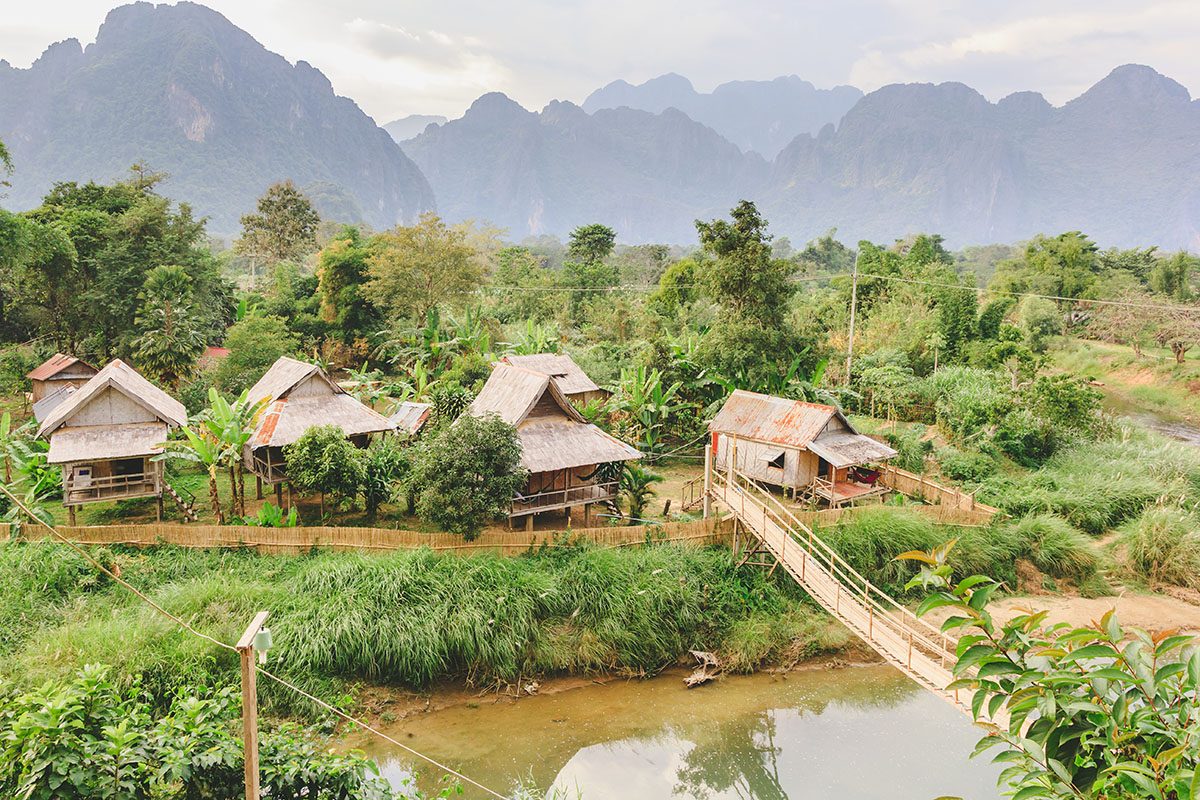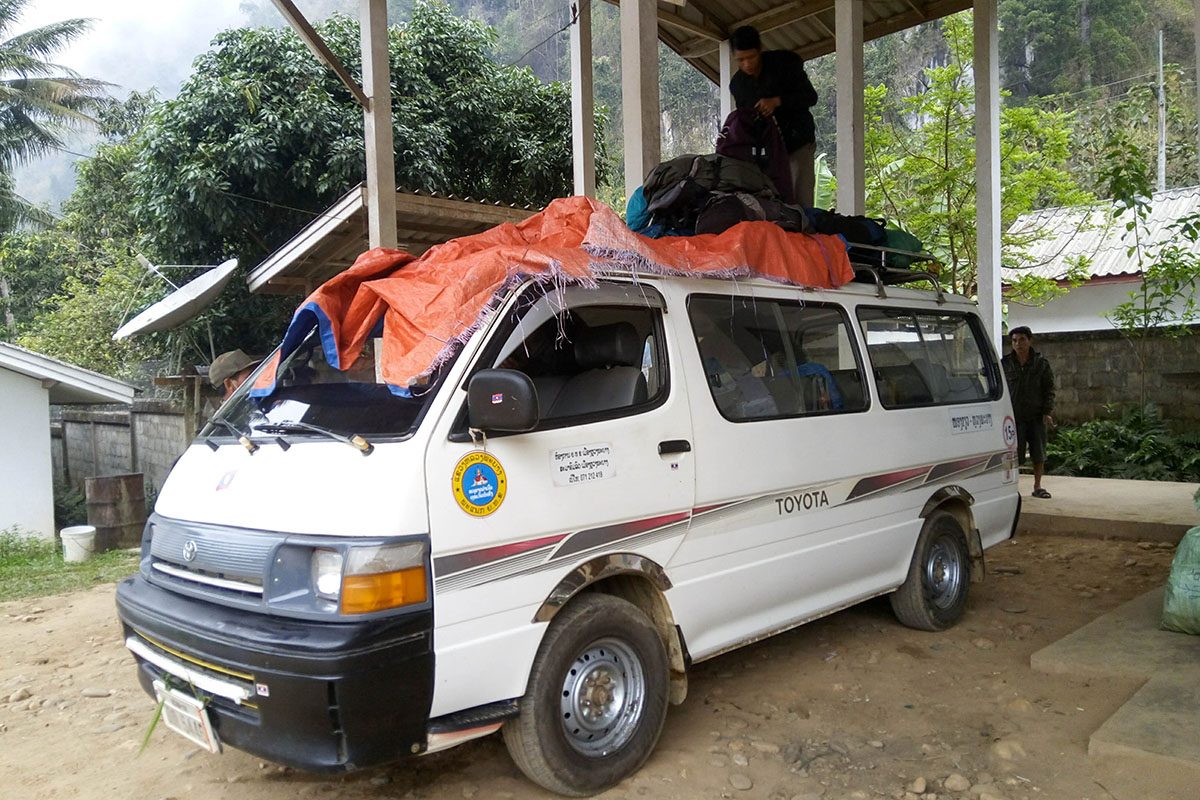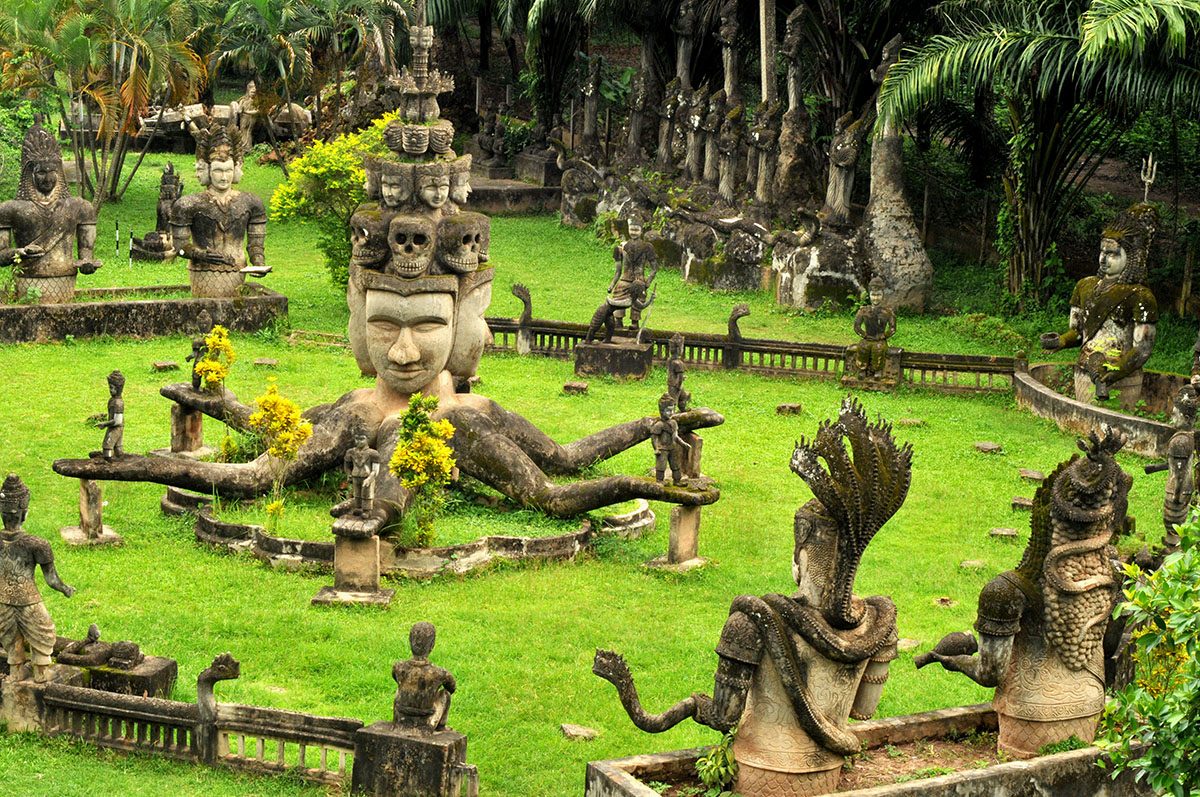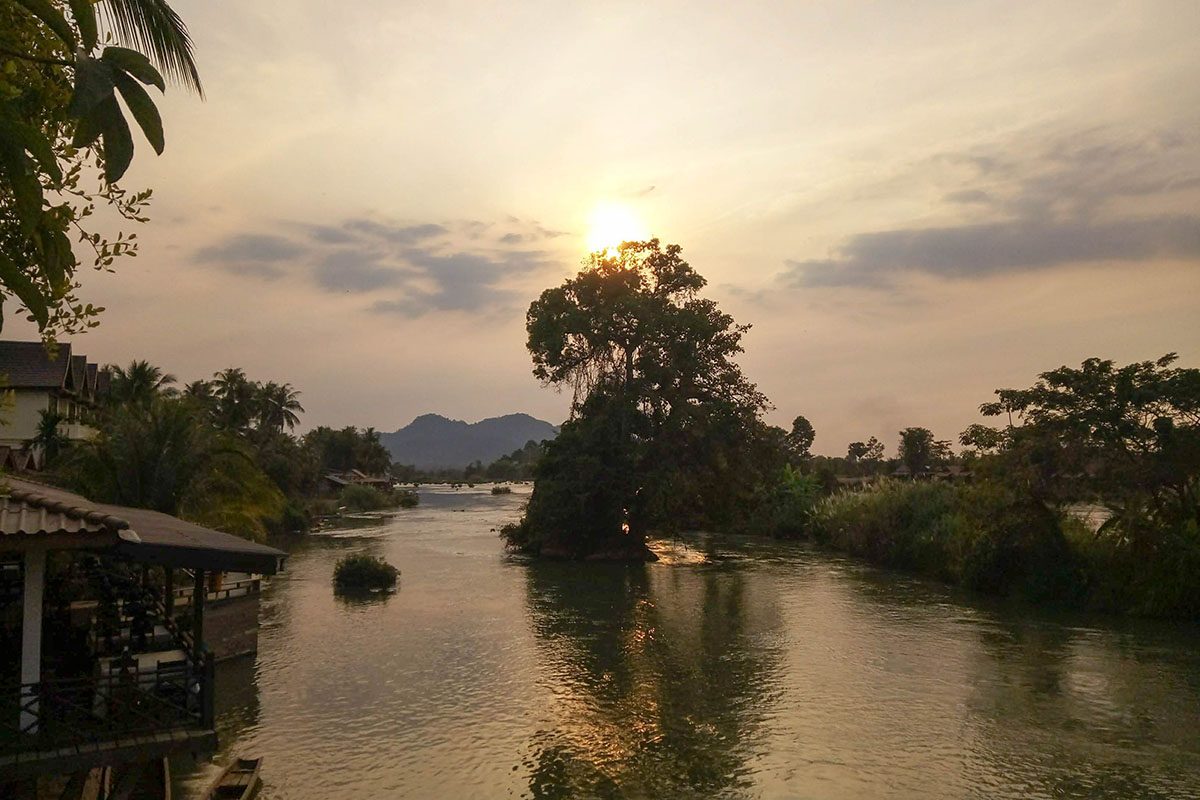As you may know if you’re following along on the ‘gram (if you’re not, come join, it’s a party), I spent the first month of 2019 backpacking in Laos. Why Laos? Many people asked. I had a whole month to play with, why not see more of Thailand or Cambodia, more famous backpacking destinations?
Truth be told, I was intrigued. I’d visited Thailand and Vietnam, and was curious to experience the ‘middle man’ between the two. I knew that a lot of backpackers in South East Asia skipped over Laos because ‘there’s not much to do’, but I was pretty sure that there was more to do.
So I did it. I travelled from Siem Reap in Cambodia northwards, ending my Lao adventure in the northern highlands of Nong Khiaw. I saw waterfalls, mountains, traditional life and French colonial architecture. I also experienced Lao hospitals, I waited for eternities for buses to leave and felt motion sickness like I’ve never felt before.
All things considered, I’m here to tell you I flippin’ love Laos. And it’s well worth dedicating at least a month of your South East Asian itinerary to.
If you’re planning a trip to Laos, check out my Laos itinerary that covers all of the spots I visited during my month there. It’s full of Laos travel tips and useful information for travelling around the region.
But if you’re backpacking Laos, you might be wondering ‘what should I know about it’? Well, I’m here to answer your questions with some off the wall things that you might want t consider before backpacking around Laos.
Well, just call me the travel information fairy, because I’m here to make all your dreams come true*.
*Disclaimer: only in terms of information about Laos backpacking. I’d love to make all of your other dreams come true, but that might be a bit out of my league at the moment.
Backpacking Laos: things you should know
1. Actual travel in Laos takes a long time
One of the best Laos travel tips I can bestow on you is – download plenty of podcasts and make sure you have a spare pair of headphones.
Travelling in Laos is a lengthy process. A lot of buses and pick-ups don’t have set times and just leave when they’re full. Then sometimes they can take the time specified, sometimes 4 hours more – for no real reason. There isn’t much traffic in Laos but sometimes delays just happen, and you’ll never know why.
There are no passenger trains in Laos, so you’ll be getting from city to city by bus, van or songathew. You can choose from VIP buses, which go more or less directly to one place (although they do sometimes still stop in other places), or local buses, which stop absolutely everywhere and never refuse admission because they’re too full, even if there are people hanging out the windows.
Of course, local buses are cheaper. I’d recommend taking both in Laos, just for the experience! But do remember that even VIP buses are not immune to long delays.
2. As do many other things!
Just don’t expect anything to happen quickly here. Ordered some spring rolls? Give it 20 minutes Coffee? Similar time. You may well end up jumping in a tuk-tuk to find it waits until it is full (if it does this, make sure you negotiate the price!), waiting around for tours to leave, or worrying when you arrive to check in to a hotel and nobody is there. They’ll turn up. Just give ‘em some time.
3. It is the most bombed country in history
This is an absolutely shocking fact that not many people know. During the Vietnam War, Laos suffered hugely. It’s called the ‘Secret War’ in the rest of the world, but let me tell you – it certainly wasn’t secret for Laos.
More than 270 million cluster bombs were dropped on Laos during the war.
Just to put that into perspective, 60 million bombs were dropped in Iraq in 1991, 1998 and 2006 combined.
Up to 80 million of the dropped bombs did not explode. This means that the countryside of Laos is still littered with unexploded ordnance (UXOs) which can still be activated. People still trigger them and die, or lose their limbs, today.
Please make sure you understand this before going backpacking in Laos – the country has been through a lot. Visiting the COPE centre in Vientiane or the UXO museum in Luang Prabang will help you deepen your knowledge about this sad part of Laos’ history.
4. Its capital is nothing like any other South East Asian capital
If you’ve been to Bangkok or Hanoi, you’ll be used to cars, bikes and lots of people. Vientiane still has cars, bikes and people, but there are less sounds of horns and engines, and the atmosphere is just so… chill.
Compared to anywhere else in Laos, it’s definitely a city, but it’s really small. While (contrary to popular opinion) I think that there are quite a few things to do in Vientiane and I was happy to spend two and a half days there, many travellers opt to just get in and get out.
I don’t think it lacks attractions at all, and I loved the atmosphere of the place. But it’s true that it doesn’t have quite as much draw as other South East Asian capitals. But don’t skip right through, give the place a chance and check out some of the best things to do in Vientiane.
5. There isn’t much English
In neighbouring Thailand, many people can speak a bit of English, and it’s not uncommon to get talking to someone who is near fluent. In Vietnam, most people in the tourism industries at least speak good English. I’ve only been to Siem Reap in Cambodia, where everyone speaks amazing English due to the huge amount of tourism. But it’s not really like that at all in Laos.
Generally, people working at hostels and nicer hotels will speak English, but people running guesthouses probably won’t. Some waiters/ waitresses will, depending on the place, but many won’t – although the menus will probably have translations that you can point to (unless you’re going super local). Bus and tuk-tuk drivers probably won’t speak much, but may want to practice with you.
So how do you get around? I use the magic formula that has always worked for me before: lots of miming, occasionally drawing a picture and resorting to Google translate if I need to. It generally works pretty well!
6. There is so much more than Vang Vieng!

When I told people I’d spent one month in Laos, I kept getting the same immediate question ‘did you go to Vang Vieng’?
Answer: yes, I did. It was the place I liked least in Laos. I wish I hadn’t gone.
Look, I do get the appeal of Vang Vieng – it’s definitely one of the most beautiful places to visit in Laos – and I’m not going to tell anyone to not go. But all those blogs saying that it’s calmed down and is basically a rural retreat now aren’t entirely correct. It’s still a party haven. And it’s still a party haven in the very underdeveloped country of Laos.
I just find it weird – a town that only caters to Western backpackers who want to party, full of western-run businesses, when there are people who could really benefit from tourist money living just outside the town.
It’s still beautiful, yes, and there are hiking trails and swimming holes and scenic rice terraces – but there are nicer places elsewhere in Laos that don’t have the whole ‘tarnished’ feeling.
So by all means, go to Vang Vieng, but please don’t be that backpacker who gets way too messed up and acts like a moron, disrespecting Laos culture in the process. Try to at least benefit the local people while you’re there. Don’t be rowdy on the streets. And for the love of god, don’t get pissed up, go tubing and do one of the most hazourdous things that led to a lot of backpacker deaths back in the day (like the so-called ‘Death Slide’, that people carried on going on, even after it was dubbed this).
And if you don’t fancy drinking cheap beer with a load of other westerners in a very non-authentic town? Skip it. I much preferred Thakhek in the south and Nong Khiaw in the north anyway.
7. It’s more expensive than other places in South East Asia
Economically, Vietnam and Thailand are doing a lot better than Laos – and with the famous Angkor Wat and its coastline and islands, Cambodia without a doubt receives more tourism.
Even though Laos sees the least tourists by far, it is the most expensive for people to travel to. This is mainly to do with the fact that tourism is so new, and a lot of prices are just kind of made up.
I’m normally pretty chill about paying tourist tax, but I did have to put my foot down a couple of times in Laos when I was quoted the equivalent of £5 for an under 10-minute tuk-tuk journey!
Food comes in at 2-3 for a meal and buses can cost anywhere between 3-20, depending on how far you’re going. Accommodation is generally pretty cheap – around the same as its neighbours – the lowest I paid was 5 for a twin room for a night (so split this was a princely 2.50!) and around 3 for a dorm bed.
It’s still cheap to backpack in Laos, especially if you’re from or are used to travelling in Western countries, but it’s not one of the most budget-friendly countries in the world.
8. It’s a very religious country
This kind of links into my Vang Vieng rant – Laos is super religious, so much so that there’s a country-wide curfew of midnight to ensure that religious people get enough sleep before waking to pray at 5am. I am literally so down for a curfew to get a good kip before waking up early – this is my life – so I felt very in sync with Laos.
This is another reason why I just can’t get behind partying in Vang Vieng. The entire country has this curfew, but bars in Vang Vieng stay open until 4am… idk, just doesn’t seem right to me.
Anyway, I’ll quit the ranting. Laos is a Buddhist nation, with plenty of ornate temples and Buddha statues. They’re kind of similar to Thai temples, although do have some differences, and the monks are dressed a little differently.
You’ll probably experience some ‘temple fatigue’ while backpacking around Laos, but do try to fight through it if you can – you’ll be missing them once you return home!
When you enter a Lao temple, it’s important to be respectful. This includes covering your knees and shoulders, taking your shoes off (unless otherwise stated), keeping quiet if people are meditating or if there are any signs requesting you be and obviously not being obscene (I’m sure I didn’t have to tell ya that, but you never know).
It’s also important to not point your feet at the Buddha when in a temple – this is very disrespectful to worshippers, so take care of this while in temples.
0. You won’t find many hostels out of the main touristy areas
Hostels in Laos are few and far between. There are some in the cities and a collection in Vang Vieng, but generally, it’s all about guesthouses here. And they’re pretty cheap – you’ll be paying about double the price of a dorm bed (most were around 70,000 kip) so if you can split it, then it works out great.
I found that some of the hostels that there were in Laos could be a bit outdated. The two exceptions to this were Chato Hostel in Pakse and My Box Hostel in Vientiane. It’s definitely worth checking these two out!
10. The nature is unbelievable
Laos is probably the best country in the region in terms of nature. It has mountains, plateaus, rivers, sunsets, jungle and caves. There are plenty of scenes that’ll make you think OMG DO PLACES LIKE THIS EVEN EXIST and your Instagram will have never looked so good.
I’m not going to be able to list them all here, but some of my favourite natural spots in Laos include:
- Sunset over the Mekong on the 4000 islands
- The waterfalls on the Boleavan Plateau
- Mountains near Thakhek
- Kong Lor Cave
- Nong Khiaw village which is nestled in mountains – here’s how to go hiking in Nong Khiaw.
It’s all abso-bladdy-lutely beautiful.
11. Elephant tourism is still a big problem here. Please don’t support the wrong companies.
Elephant tourism is a bit of an issue all over South East Asia (they are found in Myanmar, Thailand, Cambodia and Laos, as well as Nepal and India). We all know that we shouldn’t be riding elephants – if you don’t, here’s why – but we also shouldn’t be supporting ‘sanctuaries’ that aren’t actual sanctuaries.
Many places in Laos still offer riding, and many don’t, but still make the elephants behave unnaturally for tourists amusement. If there’s no real reason that the elephant should be in a sanctuary, the sanctuary isn’t ethical.
Sanctuaries should only be operating to care for animals that can’t survive in the wild at present, and tourists visiting should have no impact on what they do.
I haven’t personally been to any elephant sanctuaries in Laos, but the only ones that seem ethical from my research are MandaLao and the Elephant Conservation Center near Luang Prabang – I haven’t personally been to either though, so do let me know if you have and have any comments about them.
There are a few more ethical elephant sanctuaries in neighbouring Thailand – read about my day at Elephant Nature Park here.
12. Be prepared to eat sticky rice like you’ve never ate it before
I mean, you probably didn’t eat all that much sticky rice before your Laos backpacking adventure, but you’re gonna eat tons here. Laos eats more sticky rice per capita than anywhere else on this planet. They love it here.
It’s actually a different type of rice to steamed rice, which is how it manages to be sticky. You basically grab it with your fingers (knives and forks aren’t an option here, I’m afraid), roll it into a ball and dip it into whatever you have to eat it with. This could be anything – a chilli sauce, various vegetable dishes and tofu larb were generally my sticky rice accompaniments of choice.
You’ll end up eating all of this with your hands, so it might be an idea to carry round a small bottle of hand sanitizer for those times when sticky rice eating is thrust upon you. This happens more often than you’d think.
13. It’s all about the Mekong
The Mekong is vital for Laos life. From providing connections to four other countries, to creating electricity, to providing food; it’s been essential for the country’s development.
As tourism increases, the Mekong is proving itself useful once again. The 4,000 islands in the south are now popular tourist hotspots and the slow boat to the Thai border is one of the most popular things to do in Laos. The Mekong largely makes up the border between Laos and Thailand, so it also is significant in relations between the two neighbouring countries.
You’ll no doubt get the chance to enjoy the Mekong throughout your time in Laos. The sunsets over it are incredible, boat trips enjoy spectacular views, and it’s always fun to think ‘I’m standing here in Laos and over there is Thailand’ (that might just be me, I geek out on country borders).
It’s definitely a significant natural phenomenon that has shaped Laos’ progress as a country, so be sure to fully appreciate it while you’re there!
14. Laos has 4000 islands, despite being landlocked
Laos is the only landlocked country in South East Asia – but it has 4000 islands. How, I hear you ask? It’s because of our buddy the Mekong – who is so wide in southern Laos that its home to not one, but 4000 islands.
Most of these are tiny and uninhabitable, but three have hotels, restaurants and inhabitants. These are Don Det, Don Khong and the similarly named Don Khon. Don Det is where most of the tourism is based – Don Khong is connected by a bridge and is more chill, yet still has some restaurants and guesthouses, and Don Khon sees very few tourists.
It’s well worth checking out these islands in a river for some beach time (apparently you can swim in the Mekong – I personally wouldn’t, but you do you) and just to enjoy another part of the rich tapestry that is travelling in Laos. You can see some of the best things to do in Don Det here.
15. It’s the place to go to get your French fix (apart from France)
Laos was a French colony from 1893 until 1946; which means that it still has a lot of French architecture, still serves plenty of food inspired by the French and some people even speak a funny version of French.
It’s pretty much the only place in South East Asia where you’ll get decent wine – even though Cambodia and Vietnam were also French colonies, you won’t get as much French wine or French anything there.
This is mainly because when the French came along, Laos wasn’t as established a country as Vietnam and Cambodia – it was more like a collection of many groups. This meant that French culture and language was able to infiltrate more than its neighbours.
In Vietnam, talking French in schools was banned, and focus was on English; they didn’t reject French in the same way as Laos. And as Laos doesn’t develop as fast as Cambodia and especially Vietnam (which has probably developed a few lightyears since I was last there 4 months ago), it still holds onto some of its French roots.
I won’t go into a big tirade about colonialism here, but it goes without saying that it’s more bad than good – however, the French architecture, food and language is generally quite pleasant in modern day Laos.
16. Please don’t go mad on the happy pizzas
By ‘don’t go mad’, I mean ‘don’t do them’. Please. Marijuana has infiltrated in from western cultures, and Laos really doesn’t need an undercover drug world that’s supported by tourist dollar. Same goes for opium in the north; Lao communities are working hard to eradicate opium abuse, so it shouldn’t be propped up by tourists.
Plus, if you’re caught – which has happened at bars selling the stuff (the police won’t care about Lao people selling it, they care about tourists buying it) – you could be facing a fine of a few hundred dollars or deportation in the best case, and a couple of years in a Lao prison or worse in the worst case scenario.
Just go and enjoy a Beerlao or some Lao Lao whiskey, please.
17. There are all sorts of animals in Laos
Laos is home to all sorts of funky creatures! Tigers, gibbons, snakes, bears and the endangered Irwaddy dolphin all call this country home. You might be lucky and see some in their natural habitat while in Laos; but remember to pay them respect and follow any safety procedures recommended by locals.
18. Change your kip before you leave!
You’ll have lots of kips in Laos. It’s the currency. One US dollar is 8,582.50 Laos kip, and one GBP is 11,346.06. Nice and simple to convert! I generally just divided everything by 10,000 and decided that was around a pound.
Anyway, my actual useful Laos travel tip in regards to kip is to change it before you leave the country. You literally cannot change it anywhere outside of Laos. So make sure you leave Laos with no kip whatsoever. You have been warned.
(I mean, nothing’s going to happen, but it’s a bit of a nuisance).
19. Laos is home to over 60 ethnic groups
There are all sorts of different ethnicities in Laos, with only 68% of the population identifying as ethnically Laos. This means that culture and customs can change quite dramatically from place to place, especially if you’re in an area with lots of ethnic groups like the Bolevan Plateau or the mountains of the north. Do bear this in mind while travelling around Laos, and be repsectful at all times.
Are you ready to go backpacking in Laos?
Laos is such an amazing country. It’s got culture, nature, history, lovely people and great food. So many travellers rush through – or even skip over – Laos, but to me, it really is a gem of South East Asia. I hope you love it as much as I did!
If you enjoyed this blog post, please share it or follow me on Instagram, Facebook and Youtube!












So glad a read a blog post that says that Laos is more expensive than any other country in SE Asia. Because it’s so true! We’ve come across many travellers telling us otherwise, but our budget suffered tremendously compared to our expenses in Vietnam, Thailand and Cambodia.
Vang Vieng wasn’t our scene either, we spend there one night and moved on. I wish we spent more time in Laos though, especially the islands. But we experienced an insane heatwave during our visit and flew over to Vietnam in search of cooler weather. Great post! 🙂
Yes it definitely is pricier! It’s worth it though, awesome country 🙂 I was there in January and Don Det/ Pakse were extremely hot then so I can only imagine them in a heatwave!
Laos is a Buddhist country and you will see many monks on the streets of Laos they might even travel on the bus with you. I was surprised to find how approachable the monks were in Laos! They will often talk to you to practise their English ??
Yes I met a few friendly monks in Laos, it was really nice to chat to them!